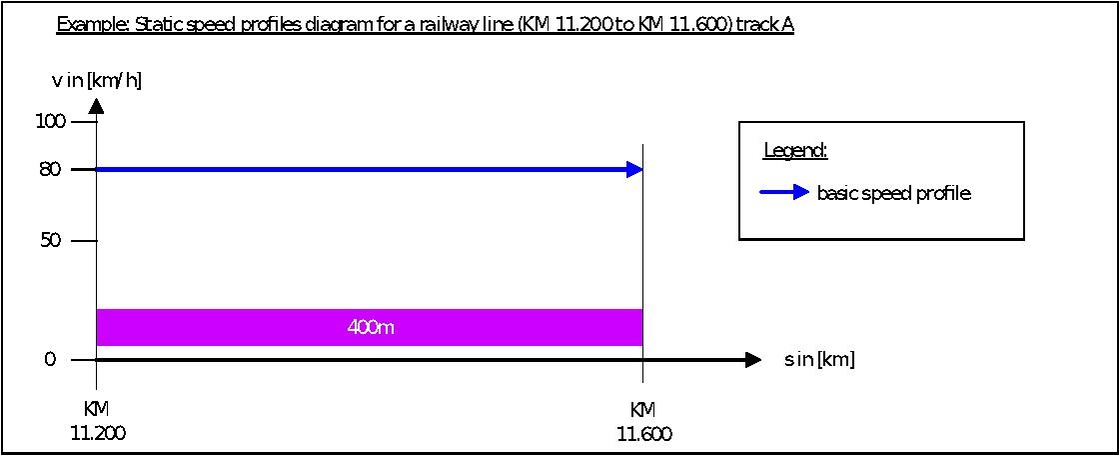User:RailML Coord Documentation/IS:speedSection: Difference between revisions
(→Introduction: Markups) |
|||
| Line 6: | Line 6: | ||
== Best Practice / Examples == | == Best Practice / Examples == | ||
A speed limit valid for a speed section is presented in {{rml}} by a speedSection element. The speedSection element defines the start and end location of the speed section and the maximum speed limit valid for this section. | A speed limit valid for a speed section is presented in {{rml}} by a {{tag|is|speedSection}} element. The {{tag|is|speedSection}} element defines the start and end location of the speed section and the maximum speed limit valid for this section. | ||
<div class="res-img"> | |||
[[file:speedProfile1.pdf]] | |||
</div>''Example Static Speed Profile for a railway track section'' | |||
;The modelling in {{rml}} is: | |||
<syntaxhighlight lang=xml> | |||
<speedSection id="spsec100" maxSpeed="80" isTemporary="false" isSignalized="false"> | |||
<name name="JNA-201" description="Speed section" language="EN"/> | |||
<linearLocation id="spsec100_lloc" applicationDirection="normal"> | |||
<associatedNetElement netElementRef="ne_102" keepsOrientation="true" | |||
posBegin="200.0" posEnd="600.0"> | |||
<linearCoordinateBegin positioningSystemRef="lps01" measure="11200.0"/> | |||
<linearCoordinateEnd positioningSystemRef="lps01" measure="11600.0"/> | |||
</associatedNetElement> | |||
</linearLocation> | |||
<validForSpeedProfile ref="ssp_basic"/> | |||
</speedSection> | |||
</syntaxhighlight> | |||
Each {{rml}} {{tag|is|speedSection}} element must reference (at least) one global defined {{rml}} {{tag|co|speedProfile}} element. A {{tag|co|speedProfile}} element specifies a train type for which the speed limit given by a {{tag|is|speedSection}} element shall be valid. | |||
For example a {{tag|co|speedProfile}} element can be used to provide for ETCS a '''''Basic''' Static Speed Profile'', a '''''Specific''' Static Speed Profile'' (cant deficiency or brake type depending train categories, ETCS Operational Train categories or International Train Categories) or an '''''Axle Load''' Speed Profile''. For detailed information see speedProfile Element (section X) | |||
;Example: | ;Example: | ||
<syntaxhighlight lang=xml> | |||
<common id="co_01"> | |||
<speedProfiles> | |||
<speedProfile id="ssp_Basic" isBasicSpeedProfile="true" mVersion="32"> | |||
<name name="ETCS Basic SSP" description="Basic ETCS static | |||
speed profile used by trains for which no Specific SSP matches" | |||
language="EN"/> | |||
</speedProfile> | |||
</speedProfiles> | |||
</common> | |||
</syntaxhighlight> | |||
language= | |||
</ | |||
== Additional Information == | == Additional Information == | ||
Revision as of 19:33, 20 December 2021
The element “speedSection”
Introduction
Speed limits are modelled in railML® using <speedSection> elements in combination with <speedProfile> elements. A simple example is shown below. A more complex example is provided in Example 3 of railML® element <speedProfile>.
Best Practice / Examples
A speed limit valid for a speed section is presented in railML® by a <speedSection> element. The <speedSection> element defines the start and end location of the speed section and the maximum speed limit valid for this section.
Example Static Speed Profile for a railway track section
- The modelling in railML® is
<speedSection id="spsec100" maxSpeed="80" isTemporary="false" isSignalized="false"> <name name="JNA-201" description="Speed section" language="EN"/> <linearLocation id="spsec100_lloc" applicationDirection="normal"> <associatedNetElement netElementRef="ne_102" keepsOrientation="true" posBegin="200.0" posEnd="600.0"> <linearCoordinateBegin positioningSystemRef="lps01" measure="11200.0"/> <linearCoordinateEnd positioningSystemRef="lps01" measure="11600.0"/> </associatedNetElement> </linearLocation> <validForSpeedProfile ref="ssp_basic"/> </speedSection>
Each railML® <speedSection> element must reference (at least) one global defined railML® <speedProfile> element. A <speedProfile> element specifies a train type for which the speed limit given by a <speedSection> element shall be valid.
For example a <speedProfile> element can be used to provide for ETCS a Basic Static Speed Profile, a Specific Static Speed Profile (cant deficiency or brake type depending train categories, ETCS Operational Train categories or International Train Categories) or an Axle Load Speed Profile. For detailed information see speedProfile Element (section X)
- Example
<common id="co_01"> <speedProfiles> <speedProfile id="ssp_Basic" isBasicSpeedProfile="true" mVersion="32"> <name name="ETCS Basic SSP" description="Basic ETCS static speed profile used by trains for which no Specific SSP matches" language="EN"/> </speedProfile> </speedProfiles> </common>
Additional Information
Notes
--- (no notes) ---
Open Issues
- Shall the location of “speedSection” in railML® provided as linear element or as area element?
- A railML® attribute in the speedSection element is missing to represent the UNISIG variable Q_FRONT.
